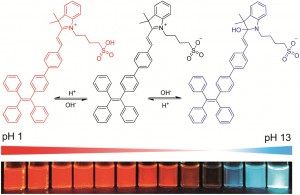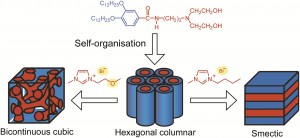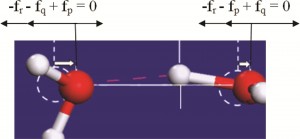Chemical Science and ChemComm are sponsoring the symposium on Playing Ball: Molecular Recognition and Modern Physical Organic Chemistry in honour of Professor Julius Rebek Jr at the spring ACS meeting. To celebrate, we’re giving free access to some recent articles from Professor Rebek and the symposium speakers until 1st April.
Why don’t you have a read and let us know what you think?
Encapsulation of the uranyl dication
Stephan Beer, Orion B. Berryman, Dariush Ajami and Julius Rebek Jr., Chem. Sci., 2010, 1, 43-47
Shape-shifting in contorted dibenzotetrathienocoronenes
Chien-Yang Chiu, Bumjung Kim, Alon A. Gorodetsky, Wesley Sattler, Sujun Wei, Aaron Sattler, Michael Steigerwald and Colin Nuckolls, Chem. Sci., 2011, 2, 1480-1486
Gas-phase H/D-exchange reactions on resorcinarene and pyrogallarene capsules: Proton transport through a one-dimensional Grotthuss mechanism
Henrik D. F. Winkler, Egor V. Dzyuba, Julian A. W. Sklorz, N. Kodiah Beyeh, Kari Rissanen and Christoph A. Schalley, Chem. Sci., 2011, 2, 615-624
A dissymmetric molecular capsule with polar interior and two mechanically locked hemispheres
Marcos Chas and Pablo Ballester, Chem. Sci., 2012, 3, 186-191
A benzocrown-6-calix[4]arene methacrylate copolymer: Selective extraction of caesium ions from a multi-component system
Brett M. Rambo, Sung Kuk Kim, Jong Seung Kim, Christopher W. Bielawski and Jonathan L. Sessler, Chem. Sci., 2010, 1, 716-722
Cell surface-based differentiation of cell types and cancer states using a gold nanoparticle-GFP based sensing array
Avinash Bajaj, Subinoy Rana, Oscar R. Miranda, Joseph C. Yawe, D. Joseph Jerry, Uwe H. F. Bunz and Vincent M. Rotello, Chem. Sci., 2010, 1, 134-138
Donor-substituted octacyano[4]dendralenes: a new class of cyano-rich non-planar organic acceptors
Benjamin Breiten, Yi-Lin Wu, Peter D. Jarowski, Jean-Paul Gisselbrecht, Corinne Boudon, Markus Griesser, Christine Onitsch, Georg Gescheidt, W. Bernd Schweizer, Nicolle Langer, Christian Lennartz and François Diederich, Chem. Sci., 2011, 2, 88-93
A transparent photo-responsive organogel based on a glycoluril supergelator
Konrad Tiefenbacher, Henry Dube, Dariush Ajami and Julius Rebek, Chem. Commun., 2011, 47, 7341-7343
Recent advances in hydrogen-bonded hexameric encapsulation complexes
Liat Avram, Yoram Cohen and Julius Rebek Jr., Chem. Commun., 2011, 47, 5368-5375
A light controlled cavitand wall regulates guest binding
Orion B. Berryman, Aaron C. Sather and Julius Rebek Jr., Chem. Commun., 2011, 47, 656-658
Thermodynamically controlled self-sorting of hetero-bimetallic metallo-supramolecular macrocycles: what a difference a methylene group makes!
Boris Brusilowskij, Egor V. Dzyuba, Ralf W. Troff and Christoph A. Schalley, Chem. Commun., 2011, 47, 1830-1832
Anion-dependent fluorescence in bis(anilinoethynyl)pyridine derivatives: switchable ON–OFF and OFF–ON responses
Calden N. Carroll, Brian A. Coombs, Sean P. McClintock, Charles A. Johnson II, Orion B. Berryman, Darren W. Johnson and Michael M. Haley, Chem. Commun., 2011, 47, 5539-5541
Sodium and pH responsive hydrogel formation by the supramolecular system calix[4]pyrrole derivative/tetramethylammonium cation
Begoña Verdejo, Francisco Rodríguez-Llansola, Beatriu Escuder, Juan F. Miravet and Pablo Ballester, Chem. Commun., 2011, 47, 2017-2019
Conformational and spectroscopic properties of π-extended, bipyrrole-fused rubyrin and sapphyrin derivatives
Se-Young Kee, Jong Min Lim, Soo-Jin Kim, Jaeduk Yoo, Jung-Su Park, Tridib Sarma, Vincent M. Lynch, Pradeepta K. Panda, Jonathan L. Sessler, Dongho Kim and Chang-Hee Lee, Chem. Commun., 2011, 47, 6813-6815
Just add tetrazole: 5-(2-Pyrrolo)tetrazoles are simple, highly potent anion recognition elements
Rebecca J. M. Courtemanche, Thomas Pinter and Fraser Hof, Chem. Commun., 2011, 47, 12688-12690
Synthesis of cationic quantum dots via a two-step ligand exchange process
Yi-Cheun Yeh, Debabrata Patra, Bo Yan, Krishnendu Saha, Oscar R. Miranda, Chae Kyu Kim and Vincent M. Rotello, Chem. Commun., 2011, 47, 3069-3071
Expanding the chemical space for push-pull chromophores by non-concerted [2+2] and [4+2] cycloadditions: access to a highly functionalised 6,6-dicyanopentafulvene with an intense, low-energy charge-transfer band
Govindasamy Jayamurugan, Jean-Paul Gisselbrecht, Corinne Boudon, Franziska Schoenebeck, W. Bernd Schweizer, Bruno Bernet and François Diederich, Chem. Commun., 2011, 47, 4520-4522
Comments Off on Molecular recognition and modern physical organic chemistry – free articles!













